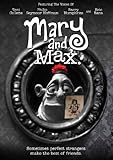 Luke encounters the Wampa whose arm he severed on the planet Hoth in this Claymation parody of the Star Wars movies.
Luke encounters the Wampa whose arm he severed on the planet Hoth in this Claymation parody of the Star Wars movies.
Mary and Max
Mary, who experiences alienation in every aspect of her life, starts out with parents who are poor, weird, and unsympathetic (her father is into taxidermy, her mother is an alcoholic who seems to do nothing but yell at her) and eventually end up dead. The visible evidence that she is neglected at home makes her a pariah at school in spite of the fact that it is the other children who are overtly engaging in bad behavior (at one point, she comes to school with a coat fastened with clothespins because her pet chicken pecked off the buttons and nobody sewed them back on, and other children harrass her in the schoolyard, with one boy going so far as to pee on her sandwich in plain sight). In an attempt to remedy her loneliness, she picks Max’s name at random out of a phone book, and is lucky enough to get a reply back from someone who is obviously sympathetic and intelligent. Max’s letters ring true to Asperger’s style: full of plain speaking, factual details, and jumping from one topic to another, but in the eyes of society and her mother, potentially dangerous and unsuitable for children. Maybe it was Max’s mention of having been a mental patient, or the frank but inappropriate discussion of his sex life (or rather, the lack thereof) that sets the mother off when she finds the first letter and throws it away, believing she is protecting her child. In spite of how this looks to her mother (and most average people), correspondence with someone who has been in her shoes as a social outcast is exactly what Mary needs. Contrary to a lot of recent portrayals, it is possible for people with Asperger’s to have friends, but in view of the fact that some of the things they do and say go against society’s notion of what is considered appropriate, this perhaps can lead to a bonding with people on the margins of society.
(Speaking of inappropriate things and portrayals of sexuality, Australia’s movie and video industry must have somewhat different standards of what is considered appropriate to show in a picture purportedly for children than prevail in the USA. Let’s just say this was the first time I’ve seen claymation genitals.)
Luckily for Mary’s emotional equilibrium, she is in a position to send another letter in which she describes the situation to Max, and comes up with a solution: he will henceforth send his letters to the address of an elderly neighbor whom she helps out.
The premise of the possibility of pen pals who can have a years-long and very intense relationship without engaging in physical contact of any sort is a theme of this and a handful of other films such as My Japanese Wife (perhaps it is increasing in popularity as global communications of every sort are becoming more widespread?)
Admittedly, some of the reactions they have to one another’s letters seem exaggerated for effect, such as the fact that Max’s objection to being used as a case study for the sake of her career in psychology sends her into a spiral of suicidality and some of Mary’s letters sent Max into “meltdown” mode and in one case, effected his return to the mental health system (where he would be told he had Asperger’s Syndrome, in spite of the fact that it was way too early in the timeline for such a thing to be possible in real life, as Asperger’s was only recognized by the American Psychological Association in 1994. And yes, someone who really does have Asperger’s really would have a problem with a purportedly serious and sensitive movie set in a specific temporal period getting a widely-known piece of factual information so glaringly wrong!)
In spite of the claymation medium, which is usually reserved for less-than-serious examples of the cinematic oeuvre, I found myself liking the overall gestalt of this picture in spite of having some problems with particular parts of it.
Movie Review by Laura Brose

